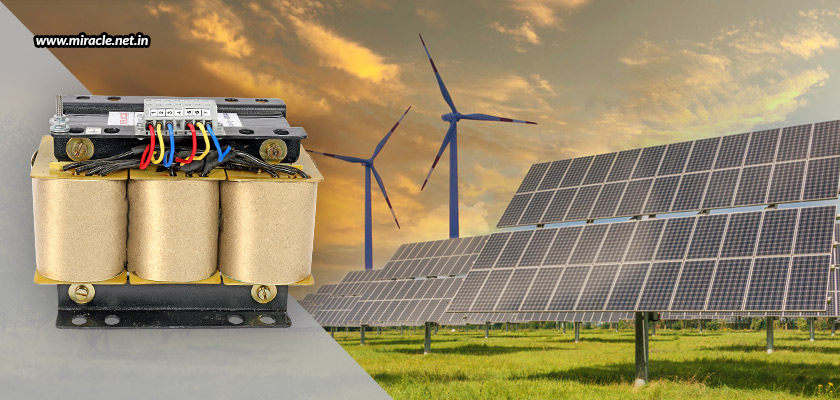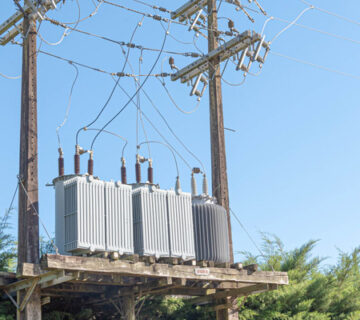Renewable energy sources, such as solar and wind power, are essential to the world’s transition towards sustainable power generation. Transformers emerge as crucial participants in this revolutionary process as we adopt cleaner alternatives and more complex technology to integrate renewable energy into the current power systems. Let’s examine the critical function transformers play in controlling power flow in smart grids, linking wind and solar farms to the grid.
Connecting wind farms to the grid
The use of wind energy has become a significantly reliable source of electricity, with wind farms using the kinetic energy of the wind to create electricity. However, these wind farms are usually located in isolated areas, in regions with strong and constant winds, distant from the cities where power is mostly used. In order to link these distant wind farms to the larger power grid, transformers serve as a bridge.
One thing to note here is that the electricity generated by wind turbines is at a comparatively low voltage. This is why step-up transformers are used here to raise the voltage to the levels appropriate for grid transmission, and then effectively transport this power across long distances. This procedure guarantees that the power may travel over long distances with minimal degradation, while also reducing energy losses during transmission.
Another critical challenge here is that because wind speeds vary, the energy generated is not stable. This again makes transformers critical as these equipment can reduce voltage fluctuations and maintain grid stability. Grid instability requires complex transformers that can adjust to changing circumstances, facilitating effective energy transfer, and preserving dependability in the face of erratic renewable energy production.
Solar farms and transformers
Along with opportunities, the solar energy used with photovoltaic panels, also brings about a number of challenges. Large-scale photovoltaic farms require effective systems for transferring and converting the power generated. Enhancing power conversion efficiency, mitigating intermittency, and grid integration are critical factors in augmenting the dependability and efficacy of solar energy as an eco-friendly energy source.
When it comes to incorporating solar energy into the grid, transformers play a very important role as they guarantee power quality by controlling voltage levels and resolving the inherent variations in solar energy. These equipment streamline the integration process by enabling smooth synchronization with the current electrical supply. Their capacity to regulate voltage improves grid stability, which supports a dependable and effective integration of solar power.
The transformers and solar inverters are required to work in tandem in order to convert solar panel-generated direct current into grid-compatible alternating current. That’s because the transformers adjust voltage levels, and solar inverters convert DC to AC; thus resulting in efficient transmission of power. Through such collaboration, the integration of solar electricity into the grid is ensured, improving the overall distribution of energy.
Managing power flow in smart grids
Smart grid technology is essential for effective energy management in the changing energy landscape. Transformers are essential components of these intelligent networks since they control the electricity’s dynamic flow. Smart transformers contribute to a more resilient and sustainable energy infrastructure by enabling real-time changes and improving grid flexibility and resilience through increased monitoring and control capabilities.
Power systems are revolutionized by smart transformers, which have sophisticated monitoring and control capabilities. By quickly resolving oscillations, they improve grid stability through real-time data analysis. Their adaptive controls make it easier to make dynamic modifications, which maximizes energy flow and increases the power system’s overall resilience. An energy infrastructure that is more resilient and responsive is largely dependent on smart transformers.
Transformers enable the integration of distributed energy resources, including renewables, in smart networks. They provide bidirectional power flow and optimize energy distribution within the system, enabling seamless integration. This flexibility facilitates the effective integration of distributed energy resources, thus enhancing grid flexibility, dependability, and the development of sustainable energy systems.
In summary, transformers are essential components that become even more important as we work through the challenges of incorporating renewable energy sources into our power systems. Transformers are essential for maintaining sustainability, efficiency, and stability in a variety of applications, including controlling solar energy, linking wind farms, and supporting smart grids. In this context, Miracle Electronics stands out as a leader in top transformer manufacturing in India, demonstrating competence in the production of transformers that facilitate the smooth integration of renewable energy sources. Miracle Electronics advances the cause of clean and efficient power generation by bringing a revolutionary aspect to the changing energy environment through dedication to innovation and quality.




